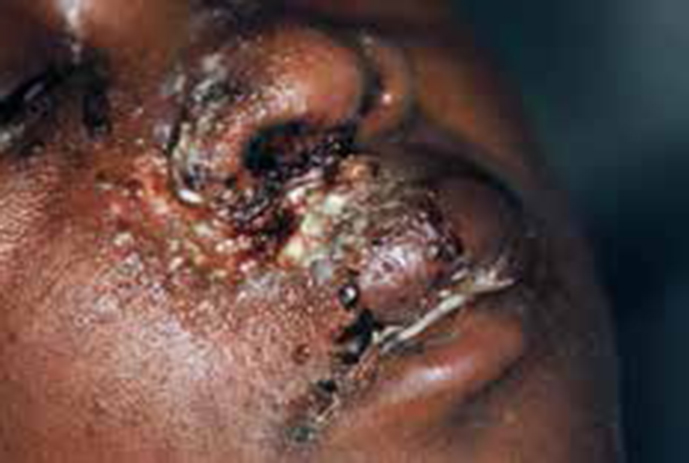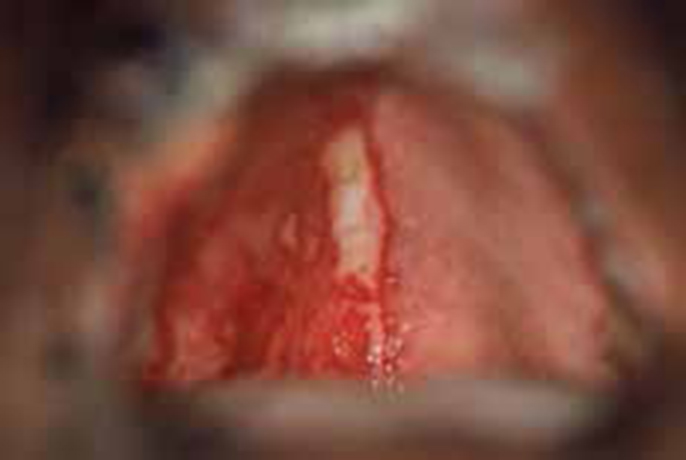Article


A 56-year-old married woman from Nigeria presented with severe right-sided orofacial pain for 2 weeks. The intense, dull, constant pain in the right maxilla preceded by 3 days the onset of oral soreness. The patient also complained of fatigue, episodes of fever (38 °C) and cervical lymphadenopathy. She had not taken any medicines, apart from analgesics. She had been recently diagnosed as HIV+ve. None of her relatives, to her knowledge, had similar lesions.
Clinical examination revealed multiple painful ulcerations on the right side of her face, mainly on her malar area and nose (Figure 1), together with scattered erosions in the right side of her palate to the middle line (Figure 2). No other lesions were found on her body.


Q1: Which other disease has appeared simultaneously with HIV infection?
A1. The answer to which other disease has appeared simultaneously with her HIV infection?
(a) Pemphigus vulgaris is a chronic autoimmune bullous disease that affects the skin and mucous membranes, including the oral mucosa. The oral lesions in pemphigus present as fragile bullae which break easily leaving extensive scattered painful ulcerations, mainly in the soft palate, floor of the mouth and lips. The skin lesions are extensive deep erosions or ulcerations often covered with bloody crusts with a tendency to enlarge in areas of pressure. The lesions in our patient share some clinical features of pemphigus (ulcerations and crusting) but have significant differences, such as their strict distribution along the trigeminal nerve maxillary dermatome, and their tendency of remaining unchanged with rubbing, and the onset of pain before the appearance of the skin/oral lesions.
(b) Herpes zoster is the answer. It is a localized infection from reactivation of the herpes varicella-zoster virus, found typically in older patients with low immunity or in people with T cell immune defects, such as in HIV/AIDS. Clinically, the initial manifestation is pain in the involved dermatome, as in our patient. Then multiple vesicles appear in the skin, which in 2–3 days break and finally crust. Ulcers form in the oral mucosa, surrounded by an erythematous zone. All skin and oral lesions are usually located ipsilaterally in one dermatome, as seen in our patient. Herpes zoster infection is associated with general symptomatology, such as fatigue, fever and lymphadenopathy, as in our patient.
(c) Acne conglobate is an uncommon severe inflammatory disease affecting the pilocebaceous glands of the trunk and face of men, mainly at the age of 18–40 years. It appears as multiple coalescent nodules, cysts and ulcerations covered with crusts interconnecting abscesses, causing severe facial disfiguration. This disease has been reported in HIV+ve patients but lacks the characteristics seen in our patient, such as the oral involvement, the older age, the negative family history and the distribution and type of skin lesions. (d) Superficial pyoderma granulosum is a rare skin condition characterized by extensive painful deep ulcerations of the skin, including the face. This disease differs from classical pyoderma gangrenosum in its indolent clinical course and lack of an underlying systemic disease, such as Crohn's disease, ulcerative colitis, polyarthritis or gammopathies. Although the skin lesions in our patient have some characteristics of superficial pyoderma gangrenosum, such as the painful ulcerations, the presence of oral lesions excludes this disease. (e) Zinc deficiency is a rare disease related to the failure of absorption of dietary zinc, or its excess excretion from the kidney. This disease can appear early in life (acrodermatitis enteropathica), or later in life, due to inflammatory bowel disease, pancreatic disease, nephrotic syndrome or malnutrition from alcoholism. Characterized by skin erythema associated with vesicles and pustules that later break and become crusted, the lesions are located on the hands and feet and around body orifices, such as the perioral and anogenital areas. Zinc deficiency can also cause oral ulcerations but the characteristic location of the skin lesions is found mainly on the extremities. No such lesions were seen in our patient.
